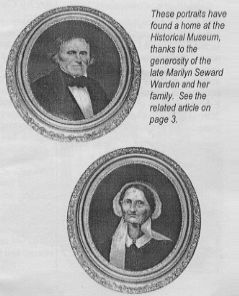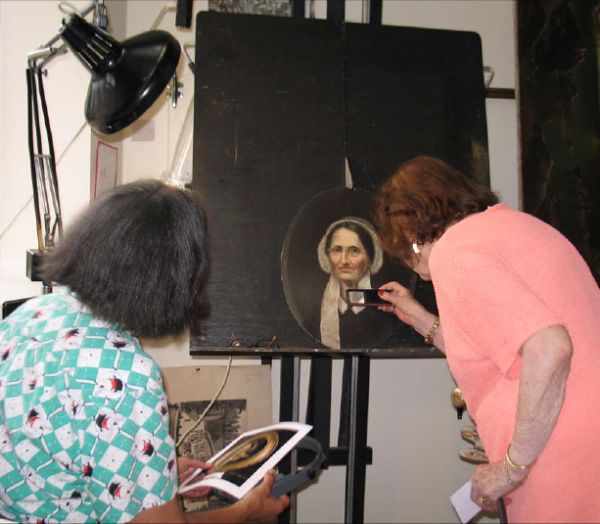Seward Portraits
Presented to
Museum2
The evening of May 3,
2004 marked an exciting
event for the Monroe
County Historical
Society and for the
citizens of Monroe Co.
as the descendants of
Marilyn Seward Warden
and her sister, Nancy
Seward Kochery/Taylor,
officially presented
portraits of Austin
Seward and his wife
Jennett Seward to our
county museum. Austin
Seward is the
blacksmith who is
credited with producing
the original fish weather
vane for the 1826
courthouse. The
portraits were painted in
the early 1860s by a
Bloomington portrait
painter, Marion Blair.
These portraits last
hung in the home of
Marilyn Warden who
passed away in Feb. of
this year. Marilyn was a
long-time faithful
volunteer at our
museum and was
especially proud to be a
part of this nearly
legendary founding
family. May 3rd would
have marked her 81st
birthday, which is why
her daughter Nancy
Wrobleski chose that
date to officially present
these wonderful
portraits.
Please visit the museum
soon to see these
outstanding paintings
and the expanded
Seward exhibit. We
celebrate this significant
addition to the
museum's collection of
Monroe County artifacts.
A Brief History of Austin Seward1
By Allison Lendman
Austin Seward was born in VA in ca 1797,
grew up in Richmond, KY where he married
Jennett "Jane" Irvin in 1817; and, in 1821, the
small family followed relatives who had earlier
moved to Monroe Co. Jane was from a
prosperous family. She was well-educated
and moved in the best society in Richmond.
Austin's early education was limited, but by
extensive reading and close observation, he
became a man of great and varied information.
He had been apprenticed at age 12 to
learn blacksmithing and was permanently
lamed while shoeing a vicious horse as a
youth, but this did not injure his spirit. He
soon was also apprenticed as an edge-tool
maker.
Upon arriving in Monroe County in 1821, just
three years after the founding of Monroe Co.
and Bloomington, the family built a log home
and blacksmith shop on the SW corner of 7th
and Walnut. Austin immediately began to
produce items that the young community's
settlers desperately needed. Axes, adzes,
scythes, knives and other articles were
shaped on his anvil. Necessity led him to
attempt things out of his line to accommodate
neighbors. A list of things he could make
eventually included nearly everything used in
Indiana in which iron or steel was involved:
bits, plows, wagon wheels, chains, bullet
molds, bear and wolf traps, the metal parts of
looms, spinning wheels, stoves, and skillets,
to name just a few. He was also a master
gunsmith and produced rifles that were in
great demand for their workmanship and
accuracy. He made them absolutely from
scratch - lock, stock, and barrel. It is said
that he could temper steel as well as the
workmen from Birmingham and Sheffield,
England. He trained numerous apprentices
who were welcomed into his home and were
cared for by Jane just as she cared for her
growing family. Eventually there were 9 sons
(two of whom died in infancy) and two daughters.
By 1828 a larger shop had been built
across the street to the east, and the family
had built a brick house in place of the cabin on
the original lot. This house was said to have
been the most consequential house in the
small settlement at that time.
Austin was also active in the community
immediately. He taught Sunday school for the
Presbyterian church in 1821 in his own cabin. He
was hired to paint the under-construction 1828
brick courthouse and to provide numerous
other services to the county - locks for the jail,
handcuffs, and a stamp for the official weights
and measures were just some of the items he
provided. He is credited with producing the
famous fish weather vane which originally
adorned Monroe County's 1826 courthouse. In
1833 he was one of the incorporators of the Monroe County Female Seminary. He organized
and led the 1st band ever active in Bloomington. All of his sons also participated in the
band from time to time. During the Civil War, Seward made a bronze cannon for the Union
Army. It was made from metal items donated by the citizens of Monroe Co. and melted
down and forged by Seward free of charge. It was pulled to lndy by a team of six horses.
He also provided large quantities of solid shot and bombshells for the Union effort.
During his life Austin counted as his intimate friends some of Bloomington's most influential
citizens including Dr. David Maxwell, Baynard R. Hall, Dr. Andrew Wylie and Governors
Whitcomb and Wright. He was also respected and loved by the common citizens of the
area. He was never known to have turned away a person in need of his products - even if
they could not pay. It is said that if two men came to him to buy a plow - one with money
and one without - the latter man would get it. He reasoned that the man with the money
would be able to get a plow somewhere else, while the poor man could not.
Baynard Hall, the first professor at the institution which was to become Indiana University,
wrote of his friend Austin Seward in his allegorical tales in his book The New Purchase. In
the book, Seward is named Vulcanus Allheart - Vulcanus after the Roman god of fire and
metalworking, and Allheart because he was just that, all heart. Hall wrote: "Never have I so
esteemed, ay, so loved anyone as Vulcanus Allheart. And who or what was he? He was
by birth a Virginian, by trade a blacksmith, by nature a gentleman and by grace a Christian.
If more be said, he was a genius."
Dr. Andrew Wylie, first president of the same institution, when he learned that Seward was
dying, cried: "This community can better spare any man in it, or the college every professor
than it can spare Mr. Seward. We can get other citizens and college professors to take
their places without any trouble, but no man can take his place!"
Austin Seward died in 1872 and was buried in the Dunn Cemetery beside his wife Jane
who had died in 1865. As the years went by, six generations of this founding family of
Bloomington, grew and adapted the business to suit the community's changing needs -
from blacksmith shop, to foundry, to machine shop, to industrial and plumbing suppliers. In
1967, Seward and Co. had the proud distinction of being the oldest business in Indiana run
by the same family in the same name. The doors of the business finally closed in
1983 after 162 years of existence.
Marion Blair,1
Painter of the Seward Portraits
Taken from: Pioneer Painters of Indiana by Wilbur D. Peat, published in 1954
 The man who made the strongest mark as a portrait painter in the village of Bloomington
during the Civil War period was Marion Blair. A native of the town, he attended the
university, married a local girl, and gradually came to be recognized as the community's
resident painter. It appears that he was unschooled in the finer points of painting; if he
received any instruction it was probably from itinerants passing through Bloomington or in
the studio of one of the artists established in Indianapolis.
The man who made the strongest mark as a portrait painter in the village of Bloomington
during the Civil War period was Marion Blair. A native of the town, he attended the
university, married a local girl, and gradually came to be recognized as the community's
resident painter. It appears that he was unschooled in the finer points of painting; if he
received any instruction it was probably from itinerants passing through Bloomington or in
the studio of one of the artists established in Indianapolis.
Blair was born in 1824, the son of Enos and Rachel Blair. When a young man he moved a
few miles south of town to a spot called Blair Hollow. His strong inclination toward art,
literature, and natural history, coupled with his antipathy for farming or manual labor of any
kind, did not make him a good provider for his growing family. His wife, unable to cope with
his habits, finally left him and moved to Kansas, taking their children with her.
Blair had a number of portrait commissions in Bloomington and apparently in Indianapolis
also. Most of his paintings seem to have been made in the 50s and early 60s. During this
period he did the portraits of Austin Seward and his wife. His last portrait is said to be of
Abraham Lincoln painted after he viewed his body lying in state in the capitol building in
Indianapolis. He died in 1901.
Seward Portrait Restorations3
The 150 year old portraits of Austin and
Jennett Seward are being restored by
Margaret Contompasis, painting
conservator at the Indiana University Art
Museum.
The oil portraits of Austin and Jennett are
part of the History Center's permanent
Seward Exhibit in the Cook Gallery. The
portraits were painted in the early 1860s by
Bloomingtonian Marion Blair. Now that the
paintings have been cleaned, Blair's tiny
signature is visible. Austin Seward was the
blacksmith believed that to have made the
fish weathervane that is atop the
courthouse.
Thank you to the Seward family members,
tea party benefit participants, and the
United Commerce Bank for the donations
that made the restoration possible. We
expect to see the restored portraits back in
the Cook Gallery by December 1.

Margaret Contompasis (left) shows the restored portrait of Jennett Seward to Nancy
Seward Taylor, great, great granddaughter of Jennett & Austin Seward.
1 This article appeared in the June-July 2004 issue of Monroe County Historian, a publication of the Monroe County Historical Society.
2 The presentation was reported in the 3 May 2004 edition of the Bloomington Herald-Times.
3 This article appeared in the October 2008 issue of Monroe County Historian.
This page was last updated 26 Mar 2012.
 The man who made the strongest mark as a portrait painter in the village of Bloomington
during the Civil War period was Marion Blair. A native of the town, he attended the
university, married a local girl, and gradually came to be recognized as the community's
resident painter. It appears that he was unschooled in the finer points of painting; if he
received any instruction it was probably from itinerants passing through Bloomington or in
the studio of one of the artists established in Indianapolis.
The man who made the strongest mark as a portrait painter in the village of Bloomington
during the Civil War period was Marion Blair. A native of the town, he attended the
university, married a local girl, and gradually came to be recognized as the community's
resident painter. It appears that he was unschooled in the finer points of painting; if he
received any instruction it was probably from itinerants passing through Bloomington or in
the studio of one of the artists established in Indianapolis.
